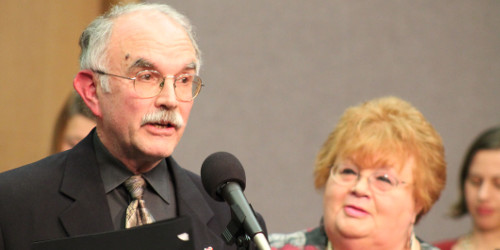
Lansing Councilmember Wood looks on as Dr. Peter Gulick addresses the audience after a resolution declared Dec. 1 "Dr. Peter G. Gulick Appreciation Day" in the city. BTL photo Todd Heywood.
LANSING — Dr. Peter Gulick was extremely uncomfortable as the Lansing City Council unanimously approved a resolution Monday night declaring Dec. 1 "Dr. Peter G. Gulick Appreciation Day" in the city. While he has toiled on the front lines against HIV since it was first reported, the public accolades for his commitments remain difficult to hear.
Randy Hannan, chief of staff to Lansing Mayor Virg Bernero, noted that Gulick preferred to stay behind the scenes.
"But that's not what we do here," he said. "We want to highlight people who are doing things to improve this community."
And no one can argue that Gulick has not had a significant impact on the Lansing community throughout the last 30 years. But his fight against the HIV epidemic was not his first choice.
Gulick was not looking at a career in infectious disease in the very early 80s. He wanted to be a medical oncologist.
He even put in a year at a hospital in Buffalo working on cancer, but family issues brought him home to Cleveland. Because he was late in applying, he was unable to get into oncology at the preeminent Cleveland Clinic, but he did get a fellowship in infectious disease.
"I just kind of did infectious disease, and I fell into treating HIV," he says. "That wasn't something — obviously — I planned, because it wasn't even a recognized disease yet."
In fact, Gulick now has the largest patient caseload in Michigan. He serves over 800 people living with HIV at three separate clinics in the state. One, located in Lansing; a second in Saginaw. His third is located in tiny Harrison, the county seat for Clare County and a town of just over 2,000 people. The Harrison Clinic is the only rural HIV clinic in Michigan. Getting there has been a journey for Gulick — both scientific and personally.
The 80s
In the very early 80s, HIV had not even been discovered. All the medical experts knew was that young men were dying from a host of bizarre infections. They discovered those men's immune systems were, for all practical purposes, decimated. When Gulick began treating these mostly young men, the disease was still called Gay Related Immune Deficiency Syndrome (GRIDS). Well into the 90s, the disease was devastating. There were no treatments for the virus — even after it was identified in 1984 — just prophylaxis for the bizarre diseases that took advantage of the defenseless bodies of those infected. Mortality was significant, Gulick recalls.
"Back then, when someone came in with a diagnosis of AIDS, you knew they were going to be dead in two years. You didn't know what would kill them, but you knew they would be dead," he said.
His colleagues knew how dispiriting the infection was. His interns would joke that Gulick was doing his rounds on "the morgue."
He distinctly recalls how that attitude impacted one patient, many years ago.
He visited the patient who had posted a sign in his room declaring that, unless visitors were going to smile, they were unwelcome. The patient informed Gulick he would no longer allow his two interns to treat him. Apparently they had not smiled.
"He said, 'I know I'm dying, and I don't need somebody to come in here and make me feel that way,'" Gulick recalls the patient telling him. "And you know what, he was right."
Gulick chastised the two interns — both incredibly gifted and well trained doctors — reminding them that until they could deal with patients, they would fail at medicine. The interns, he recalls were shocked by this revelation.
The mounting death toll hit Gulick he says.
"In retrospect, yes I was dealing with PTSD (post traumatic stress disorder)," the doctor said.
"Prior to HAART (Highly Active Antiretroviral Treatment, the first generation of multi-drug treatments that were effective in treating HIV) or ART (Antiretroviral treatment, as the treatments are known today), I was almost at the point where I needed some help psychologically," he said. "It was hard to go home every night and say, 'Well, we lost another two people, or three people.' My wife could see the change in me. I mean, I would not talk too much. I had trouble sleeping. I was just in a real depressive mood."
Welcome 1995
But then, in 1995, the discovery of protease inhibitors, a new class of anti-HIV drugs, changed everything. Used in combination with earlier classes of drugs, the so-called cocktail had a miraculous impact on patients. T-cells rose, viral loads dropped, people who were at death's door became well. Historically this is known as the Lazarus Period in HIV. And that new treatment changed Gulick as well.
"For me, it was like taking something that could make you high," he says of his elation at having a weapon in his arsenal that was able to beat back the virus. "(The drugs) changed people's lives."
Despite those drugs being a complicated treatment protocol requiring, sometimes, dozens of pills a day taken on strict time frames, and the drugs carrying significant side effects, Gulick and his patients pushed through.
He said at times he mislead some patients to keep them taking the complicated and toxic regimes. "I didn't know it at the time, but I told them the drug companies were working on new drugs. I did it to keep their hopes up — keep a little light in the distance," he said.
And he was right. Now, those toxic and complicated multi-pill treatments are mostly gone. In their place, once-a-day pills that were just as effective but with less side effects became available. In fact, while prior to these treatments life expectancy for a person diagnosed with AIDS was two years or less, today a person with an AIDS diagnosis is expected to live at least 40 years. A person diagnosed with HIV is expected to live a completely normal life span.
The infectious disease doctor says the treatment has gotten so good that he now spends a lot of time worrying about patients' aging issues — things like heart disease, one of America's number one killers.
Gulick also witnessed what he called the "good news, bad news" of the new treatment.
"The good news, 'Good, you're on medicines that are going to save your life,'" he said. "The bad news was, most of these people had given up everything. They'd sold their houses, their life insurance. They had nothing left because they were preparing to die."
Through his career, Gulick has also developed a deep sense of respect for the gay community. This, despite never having had contact with gay people prior to starting his career treating HIV.
He said it was watching the gay patients and their partners fight the disease together that helped him the most.
"Many times their families had totally given up on them, didn't want to talk to them, just abandoned them. But yet what I found was that their partner stayed at the bedside. Stayed with their loved one, just through the worst of it and didn't give up on it," he said. "They were just a support for the partner and for me as a doctor because it was so hard for me to treat young individuals that were dying and that I could do nothing about."
He said the commitment of those gay couples was something he had never witnessed. He said with other diseases, including cancer, he witnessed partners abandoning their loved ones. But not so with HIV.
And while the way we treat HIV has changed in the past three decades, he says some things remain the same. There remains a stigma to testing and access to care. One thing he has noticed is that the much ballyhooed crisis in treatment adherence, particularly among black men who have sex with men, is simply not true for his clinics.
The young black MSMs in his clinics in Saginaw are the most adherent, he says.
"I take the time to talk to them about why they need to take this drug, what it does," he says. "I explain how it will make them healthier and prevent them from transmitting the virus to others. That works."
He noted that the advent of PrEP (pre-exposure prophylaxis, a once-a-day-pill to prevent HIV) is also changing the landscape of HIV.
Gulick told the Lansing City Council on Monday night that he has hope that there will be a cure in his lifetime and during his career. It was not a false hope, he said. There are treatments in the pipeline being referred to as a cure — although he would not elaborate on those drugs.










